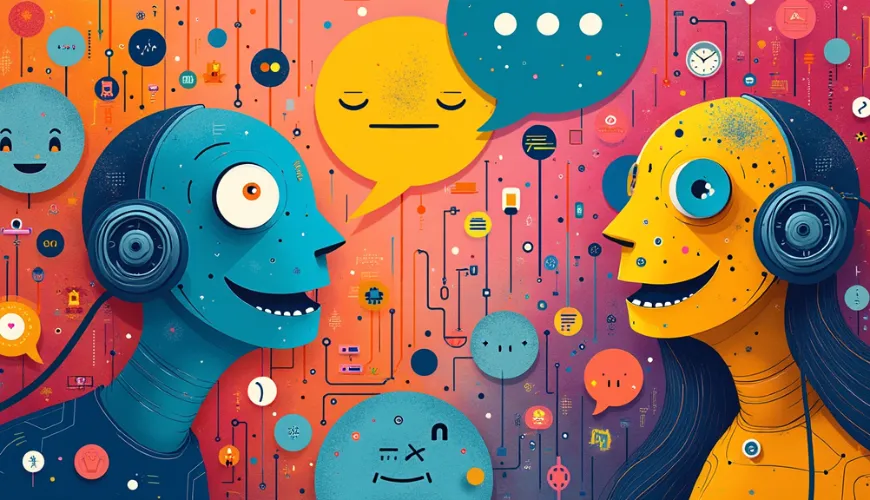AI Voice Cloning — Redefining Communication and Creativity
TL;DR AI voice cloning uses deep neural networks to reproduce a speaker's unique tone and rhythm from a short audio sample. The technology already powers faster content creation, accessibility aids, interactive entertainment, and customer‑support voices. Success hinges on consent, transparent labelling, and watermarking so that synthetic speech enhances—rather than undermines—trust.
1. From Science Fiction to Everyday Tool
A decade ago, the idea of sending a message in a voice you never recorded sounded like science‑fiction gimmickry. Today, anyone with a laptop and a clean microphone can train an AI voice generator in an afternoon and deploy it across podcasts, videos, or smart‑home devices. Adoption curves resemble those of image generators: once quality crossed an "uncanny‑valley” threshold in 2023, usage exploded in creative studios, classrooms, and even small businesses.
Creators who rely on browser helpers such as Brisk AI already know how AI assistants can condense research and draft scripts on‑the‑fly; voice cloning adds another layer of productivity by removing the need for hours in the recording booth.
2. How Neural Networks Capture the Human Voice
Modern neural voice cloning systems follow a three‑stage pipeline:
- Voice fingerprinting (encoder) A speaker‑encoder ingests 30 s – 3 min of clean speech and distils it into a high‑dimensional embedding—the "voiceprint.”
- Spectrogram prediction (text‑to‑mel) Given any text plus the embedding, a transformer or diffusion model predicts a mel‑spectrogram that matches the target voice's timbre, accent, and prosody.
- Waveform synthesis (vocoder) A neural vocoder (e.g., HiFi‑GAN) transforms the spectrogram into raw audio at 24‑48 kHz with near‑human naturalness.
Because the systems learn pitch contours and micro‑pauses, they can reproduce subtle laughter or sighs that traditional concatenative TTS never captured. Researchers continue to iterate on zero‑shot methods that require mere seconds of reference audio, opening doors for real‑time dubbing during live streams.
3. Core Use Cases You Can Try Today
3.1 Content Creation & Localization
Podcasters splice in last‑minute corrections without re‑recording; YouTubers auto‑dub into fifteen languages. A single narrator can now release an audiobook in a weekend. Education platforms leverage voice cloning AI to generate variant accents so learners hear the same lesson in British, Indian, or African‑American vernacular.
3.2 Accessibility & Voice Preservation
For patients with ALS or throat cancer, services such as VocaliD or MyOwnVoice let users "bank” their natural speech in advance, then speak through a synthetic version later. The emotional relief of "hearing yourself again” is profound—comparable to the sight‑restoring effect of text‑to‑braille.
3.3 Customer Support & Virtual Agents
Enterprises clone the warmest voices of their top agents, then deploy them in IVR menus or smart kiosks. By pairing cloned speech with an LLM, brands can maintain a consistent persona 24 / 7. Forward‑looking chat experiences like Scholar GPT hint at how a familiar voice layer can make AI tutors or knowledge bases feel less robotic.
3.4 Interactive Entertainment
Game studios modulate NPC dialogue on‑the‑fly so every play‑through sounds fresh. Streamers on Twitch swap between funny celebrity impressions using live AI voice changers, blending spontaneity with trademarked character safety by adding parody disclaimers. Even meme culture adopts synthetic speech for bits like the tongue‑in‑cheek roasting trend described in Roast AI.
4. Quality Matters: Data, Hardware, and Emotion
High realism depends on three levers:
- Dataset fidelity — background noise, clipping, and heavy compression introduce artifacts the model will copy. Aim for 44.1 kHz WAV, a quiet room, and at least 5 minutes of emotionally varied speech.
- Model capacity — larger transformer backbones capture long‑range intonation, but they need GPUs with ≥12 GB VRAM to train quickly. Cloud services hide this complexity behind an API.
- Expressive training — to convey anger, joy, or sarcasm, include lines delivered with those emotions; emotion‑tokens at inference time can then switch styles fluidly.
Realistic output may still require manual post‑processing—EQ, de‑essing, mastering—so a DAW remains handy.
5. Legal and Ethical Frontiers
The U.S. right of publicity, EU GDPR, and budding deepfake bills all converge on one rule: you must have consent to clone a living person's voice. Platforms increasingly require a signed release and watermark synthesized audio to aid detection. Non‑consensual impersonation can lead to reputational harm, fraud, or criminal liability.
The debate echoes ROM dumping in the emulation community—discussed at length in the PCSX2 BIOS guide—where the legality hinges on owning the original material. Similarly, owning a recording does not grant blanket rights to replicate the speaker's identity. Always disclose synthetic segments and keep raw prompts for audit trails.
6. Getting Started: Tool Comparison, Costs, and Workflow
| Platform | Typical Pricing | Strengths | Limitations |
|---|---|---|---|
| ElevenLabs | $5 / month for 30 k credits ≈ 30 min TTS | Zero‑shot cloning, emotion presets, high‑fidelity 48 kHz | English‑centric, watermark fee |
| Resemble.ai | $0.018 / minute (≈ $0.0003 / s) pay‑as‑you‑go; Creator plan $19 / mo | Real‑time APIs, style‑transfer, multilingual | Requires 3 min of clean data |
| Descript Overdub | Included in $16 / month Creator plan | Tight podcast/video editing workflow | Only single‑speaker use |
| Murf.ai | From $19 / month (Creator plan) | 120+ stock voices, slide narration | No personal cloning on entry tier |
| iSpeech | Credit packs (e.g., 2 000 credits for $50 ≈ $0.025/word) | Flexible TTS & IVR focus | Older vocoder, less natural prosody |
Hardware tip: A cardioid condenser mic (e.g., AT2020), pop filter, and a closet or acoustic box can raise baseline quality by 30 % versus a laptop mic—crucial for small‑data training.
Workflow checklist
- Record 3–5 min of varied speech (neutral, excited, questioning).
- Use a noise gate to cut room hiss; export 24‑bit WAV.
- Upload to your chosen platform and verify consent paperwork.
- Generate a short test script; check pronunciation of proper nouns.
- Iterate temperature / similarity sliders until tone feels natural.
- Layer background music or atmospheric effects in post.
6.1 Open‑Source vs Enterprise Options
If your project requires on‑prem control, fully open‑source stacks are emerging:
-
Coqui TTS — A permissive‑licence fork of Mozilla TTS. It supports multilingual training, style tokens, and real‑time inference on a single RTX 3060. You trade ease‑of‑use for maximum privacy. —see how similar open‑source philosophy fuels our AI Map Generator project.
-
VoiceCraft — A research repo from UCSC capable of zero‑shot emotive cloning and music generation from raw waveforms. Still experimental but advancing quickly.
At the enterprise end, Microsoft Custom Neural Voice offers bespoke models hosted in Azure. Pricing is usage‑based ($16 per 1 M characters) and subject to a rigorous Responsible AI review—a reminder that governance can be as important as raw audio quality.
6.2 Governance Check‑List
Before putting a cloned voice into production, run through this five‑point compliance list:
- Consent & Contract — Signed releases for every speaker; minors require guardian approval.
- Disclosure — Add audible or textual disclaimers whenever synthetic speech is used commercially.
- Watermarking — Embed imperceptible noise patterns or metadata so detection tools can verify origin.
- Audit Logs — Store prompts, model versions, and generation timestamps for at least 12 months.
- Revocation Protocol — Be ready to delete models if a speaker withdraws permission.
Taking governance seriously up‑front prevents costly re‑recordings or legal takedowns later.
7. Future Outlook: Multilingual, Real‑Time, and Embedded Everywhere
Research teams are tackling cross‑lingual cloning, where an English sample yields fluent Japanese or Swahili speech with the same vocal identity—hugely valuable for news‑reader avatars or in‑game localization. Edge chips like Apple's Neural Engine enable on‑device generation, so cloned voices will soon respond offline inside smart glasses or cars.
Regulation will likely mandate audio watermarks and provenance metadata. Expect browsers or messaging apps to flag synthetic voices much like email spam filters do today.
Looking slightly further ahead, researchers envision fully conversational voice clones that update in real time as your natural voice changes with age or illness. Instead of re‑recording fresh datasets every few years, continual‑learning models would adapt automatically while keeping a secure audit trail. Combine that with lightweight on‑device inference and you could dictate long emails during a train ride with no network at all—then have the same model switch into a branded persona for work calls when you reach the office. Such flexibility underscores why governance and user‑controlled opt‑outs must evolve in tandem with the underlying tech.
8. Conclusion—Bring Your Projects to Life with Claila
Voice is the most intimate signal we share online. When wielded responsibly, AI cloning amplifies creativity, inclusion, and efficiency. Claila's built‑in GPT‑powered editor already lets you draft, translate, and optimize content; now imagine pairing those workflows with your own synthetic narration to publish multilingual videos or podcasts before lunchtime.
Ready to experiment? Scroll back to the top, hit the sign‑up button, and let Claila's voice‑AI toolkit turn your words into lifelike sound.



